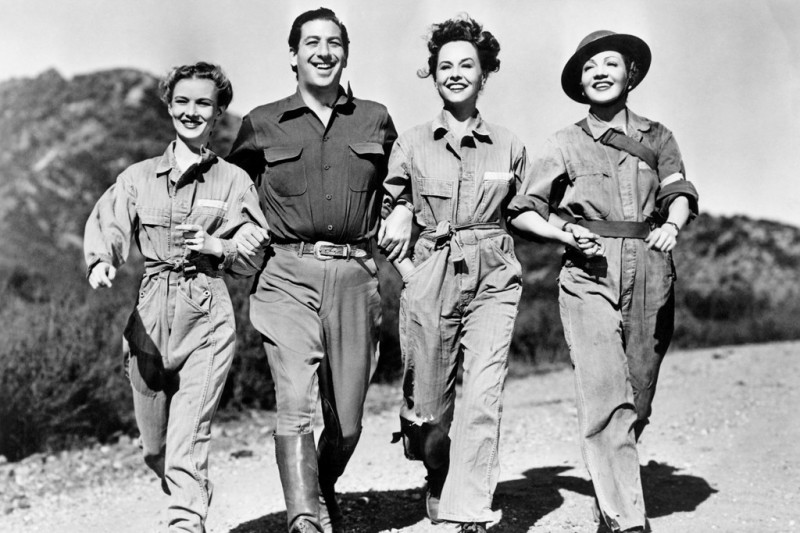« Honk for Jesus. Save your Soul | Main | The Story of Film: A New Generation »
September 06, 2022
So Proudly We Hail!

Veronica Lake, Mark Sandrich, Paulette Goddard and Claudette Colbert
Mark Sandrich - 1943
KL Studio Classics BD Region A
One of the most interesting bits of information I found on director Mark Sandrich was in Ben Sidran's book about Jews and American popular music, There was a Fire. Sidran notes that Sandrich was the creator of the playback system which totally changed the way musical numbers in films were produced. Prior to that time, filming was done completely live with an orchestra off stage while the camera was focused on keeping the singers and dancers within the frame. Sidran does not provide any attribution though an internet search indicates that dance critic Arlene Croce was his probable source. How accurate is this anecdote? I can only guess that Croce got her information as part of her research on her book on the films starring Fred Astaire and Ginger Rogers. Mark Sandrich directed five of the ten Astaire/Rogers films, plus Holiday Inn, yet has so little written about him. it is as if his being the director of these film was incidental.
After more than a decade of musicals and comedies, So Proudly We Hail! revealed a more serious side to Sandrich. While there was the dramatic Katherine Hepburn vehicle, A Woman Rebels, Sandrich minimizes the jingoism that is suggested by the title. With the exception of a couple of dramatic turns, the first hour mostly plays like a romantic comedy. The screenplay was by Allan Scott, a frequent Sandrich collaborator which explains why some of the humor is not dissimilar to some of the lines heard the Astaire/Rogers films. The film begins in December, 1941, prior to Pearl Harbor. A group of military nurses are on their way to Honolulu via a ship that is redirected to the Philippines. So Proudly We Hail was released in June, 1943, just over a year after the Battle of Bataan and the subsequent Bataan Death March took place. Between production code restrictions of the depiction of on screen violence, and military restrictions aiming to simultaneously present a reasonably accurate presentation of a major U.S. military setback while bolstering support for the war for the stateside audience, the film is probably best appreciated within the context of when it was produced.
The nurses are introduced as an ethnic cross section with characters named Sadie Schwarz, Elsie Bollenbacher and Toni Cacolli as part of the team. Claudette Colbert is their supervisor, Janet Davidson, mostly known as Davy. We are Paulette Goddard as Joan O'Doul and eventually Veronica Lake as Olivia D'Arcy. All the nurses have the rank of lieutenant. What ever idealism they have about nursing is challenged by too many wounded soldiers, and not enough sleep or medicine. The romances between Colbert and George Reeves, and Goddard and Sonny Tufts seem no less absurd that their overall situation of being virtually abandoned by the Douglas MacArthur and subject to the whims of the Japanese military. Between the narrative setup and the studio demands that allow the actors to grow stubbles while the lead actresses manage to have enough lipstick even when there is a shortage of morphone and quinine, do not expect an entirely realistic film.
What is also noticeable about Mark Sandrich is that he has a visual signature. There is a preference for traveling shots, shots that inform the viewer of the the location of a scene as well as the people within the scene. While Sandrich was required to showcase his stars, including building up Goddard's role at her request, the narrative and visual emphasis is on the group within the scene. This is made clear in the opening scene of the nurses being introduced after being rescued from Corregidor. There is no sense of hierarchy, and they express concern for the nurses who have not yet made it to safety. The title is fitting for an emphasis on the nurses as a team of equals. The "We" is inclusive of the nurses, the military, and by extension, the audience.
Film historian Julie Kirgo, formerly an integral part of the defunct Twilight Time label, provides the commentary track. Both informal and informative, Kirgo reviews the making of the film, providing the expected overview on the careers of the the three stars, but also digging into the collaboration between Sandrich and screenwriter Allan Scott, linking it their previous efforts. Time is also spent on the Oscar nominated cinematography of Charles Lang, Jr. and his dramatic use of lighting. Kirgo also points out the gender reversals in the two romantic sub-plots. A potential romance between a nurse played by Barbara Britton and a Filipino doctor played by Ted Hecht elided the Production Code. The one point I would find disputable is a reference in the film to what is now known as "The Rape of Nanjing". There is enough documentary evidence that to claim uncertainty about what happened to the Chinese female victims seems irresponsible. Otherwise, Julie Kirgo's film scholarship and passion are much appreciated. And on a personal note, I would love to see KL Studio Classics re-issue Red Line 7000 with Ms. Kirgo taking a more in-depth look at her father, the film's writer, George Kirgo.
Posted by Peter Nellhaus at September 6, 2022 06:41 AM
